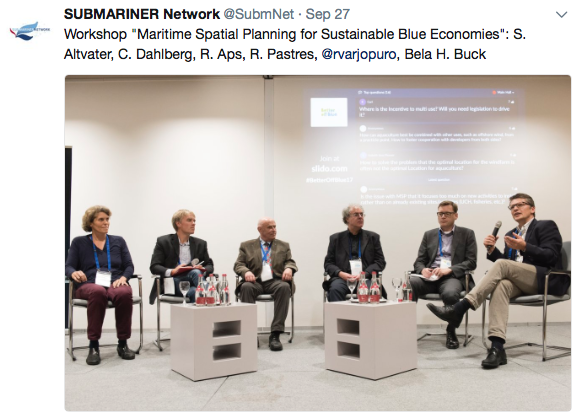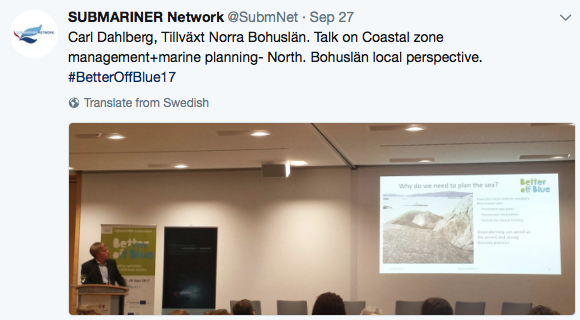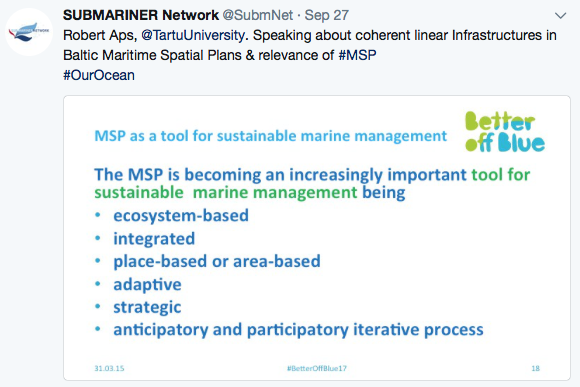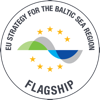
The session revolved around six presentations and interactive discussions, covering topics such as stakeholder engagement and how integrated and sustainable approaches to development might best be realised, with a key focus on multi-use and co-location. Prompted by the presentation on MSP perspectives on multi-use aquaculture concepts by Bela Buck, working with the Alfred Wagner Institute, the participants discussed how multi-use in the open seas is not yet a reality in Europe, and that measures must be taken soon to ensure adequate competitiveness with other global regions.
International cooperation
It was brought forward that 40% of projects are in fact not new ideas, but ones that have been tested ten years ago in different EU sea basins. A plea was made for more international cooperation, also especially considering the high costs of working offshore. A European cooperation on the setup of a test platform for multi-use should be promoted by EU institutions. Roberto Pastres, working with the University of Venice, presented a multi-criteria methodology for site selection in aquaculture and underlined that experiences from one sea basin can be extremely relevant for other sea basins. He presented an example from the Italian region of Emilia-Romagna, where mussel farms were developed that contributed to remediation of the marine environment and to which the local authorities responded very positively. The lessons learned from this experience could prove very useful for other sea basins, such as the Baltic Sea. Decisions on the location, size and ‘density’ of aquaculture or mussel farms should always consider both the ecological as well as the economic carrying capacity. It was suggested to motivate all EU Member States to use the WMS format in the interest of harmonising data, so that national planning processes can be aligned internationally. National and sectoral maps should then be combined, including the trade-offs between sectors such as fisheries and aquaculture. Finding and allocating suitable maritime space for sectors is an evolving exercise and not a one-off element in a planning process. The competition with other global regions is strong and joint efforts should be made regarding branding, certification, labelling and marketing. Such efforts will also make the aquaculture sector more sustainable.
Underwater Cultural Heritage
UCH is often seen as the ‘forgotten sector’, but Susanne Altvater, working for the EU MSP Platform, presented how the protection of UCH could actually prove beneficial for other maritime activities. One example came from the offshore renewable energy industry in the Netherlands, where public acceptance for planned nearshore wind parks was very low initially, and where the inclusion of UCH protection in the proposals really influenced the perception of civil society towards the planned developments. There are many uncertainties for the sector, including the actual locations of UCH sites, their size and their numbers and this is a common feature in all EU sea basins so there is a great need for European cooperation.
What is planning, and to whom?

Carl Dahlberg, working with Tillväxt Norra Bohuslän, the cooperation arena for three Swedish municipalities in the northern part of the Swedish west coast, emphasized that people often think that they know comprehensive planning, but that it is very important to invite input from people with adequate knowledge about specific issues. Marine planners have to be able to answer the question what might change through MSP in the region, and have to ensure that the right people are attending the plan development process and that they develop a sense of ownership of the process. This can be done by providing them with the right incentives, such as the notion that maritime spatial planning serves to speed up certain sectoral permitting processes. Robert Aps, working with the University of Tartu in Finland, presented the BalticLINes project and emphasized that if you want to engage stakeholders, it is important to present them with documents that are relevant and interesting to them specifically.

How to promote multi-use and co-location in the European sea basins
Riku Varjopuro, working with the Finnish Environment Institute, presented the Plan4Blue project and asked participants what the incentives are for planning for multi-use and co-location. One of the ways to promote the uptake of multi-use and to make it more feasible, is to change legislation and planning requirements, so that for instance an incentive is provided for developers to include multi-use in their proposals. Eventually, and probably not too far in the future, European sea basins will come to a situation where there will be an undeniable need for multi-use, as maritime space is being planned for and utilised more and more. Multi-use should create additional economic benefit, this is what will make it truly attractive for investors and developers. It was also suggested during the discussions that multi-use should move from the national processes to the European scale. In addition, a lot can be learned from our terrestrial friends, where multi-use is common and the environmental impacts of developments are well-researched.

Workshop presentations:
Tags: Better off blue, workshop, event, blue bioeconomy, Finland, Turku, conference, SUBMARINER Network, University of Tartu, Germany, Schleswig-Holstein



